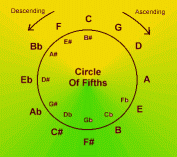


This is a combined effort with submissions by
Vern Smith and myself.
If you are not familar with chromatic & diatonic scales theory why not study the Music Theory I page before continuing on.
This section is aimed at 12 or 16 hole Chromatic Harmonicas in key of C, Solo layout. Further information is available for Chromatic Harmonicas with Altered Tunings
Transposition is the relocation of all of the pitches of a piece of music by the same interval to a different range of pitches. In Music Theory I you will see that a diatonic scale can begin on any note of the chromatic scale.
Consider the notes of a chromatic scale arranged on the face of a clock.
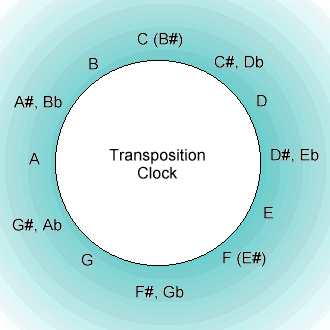
To transpose pitches N halftones , simply find each note of the piece in the origin key and step N "hours" around the clock Clock Wise for up or Counter Clock Wise for down to find the corresponding pitch in the destination key.
On the musical staff, move the tonic or keynote up or down to make it the keynote of the new key. Then move all of the other notes the same number of steps up or down. (In this case, from a line to the adjacent space is a step and from a space to an adjacent line is also a step). Then change the key signature to that of the new key.
Most computer notation programs will transpose a piece automatically, given the direction and the desired interval. In some programs, the user has only to change the key signature and the notes are automatically transposed.
This is a brief explanation of Modal Scales.
Modes originated centuries ago and used throughout a few periods since. They are still used today although perhaps not always with the same intention and style of their origins.
There are seven basic modes and can be worked out based on the major scale intervals:
| Mode | Relative to Major Scale | |
| Ionian | 1st Mode | I First Note
Major Scale 1 2 3 4 5 6 7 |
| Dorian | 2nd Mode | II Second Note 1 2 b3 4 5 6 b7 |
| Phrygian | 3rd Mode | III Third Note 1 b2 b3 4 5 b6 b7 |
| Lydian | 4th Mode | IV Fourth Note
Subdominant 1 2 3 #4 5 6 7 |
| Mixolydian | 5th Mode | V Fifth Note
Dominant 1 2 3 4 5 6 b7 |
| Aeolian | 6th Mode | VI Sixth Note
Natural Minor 1 2 b3 4 5 b6 b7 |
| Locrian | 7th Mode | VII Seventh Note
Half Diminished 1 2 b3 4 b5 b6 b7 |
To work out the structure of each modal scale using the diagram above to figure out which note on the Major scale to start on.
As discussed in Music Theory I, the Major Scale can be described as follows,
where (--) is a wholetone interval and (-) is a halftone interval.
The structure starts on the appropriate note of the major scale and steps along until completing an octave.
Two modes are immediately familar: Ionian & Aeolian. These are the Major & Natural Minor diatonic scales. Two very popular Jazz modes are Dorian &
Mixolydian, which can be found in almost every standard. In Jazz and
Blues minor keys tend to be played using Dorian scale instead of Aeolian/Natural Minor.
An example of working out a mode, for instance the Dorian Scale.
From the above chart you can see you start on the II Second note of the Major scale.
The first step (major notes II to III) is a whole tone, followed by (III to IV) a semitone step, then three more wholetones (IV,V,VI & VIII), a semitone (VII to I) and finishing with a whole tone (I to II).
The Dorian Mode Scale maps out thus:
If you wanted to play a key of D Dorian scale, you simply choose a major scale where the second note is D, which happens to be C Major.
All the notes in C Major make up D Dorian, starting on the second note.

You'll notice there are seven digits listed for each mode. Ionian mode is the Major scale, which described with digits is
Sometimes transposing and changing scales/modes is thought of as one operation and called transposition.
Once again, a clock-face diagram is useful
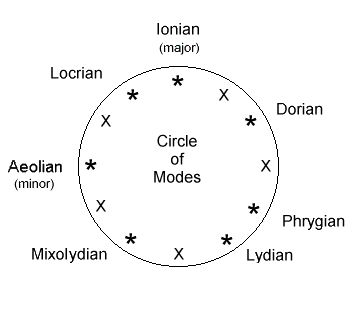
Beginning at the name of the source mode, number the asterisk "hours" with the ordinal numbers 1st, 2nd, 3rd,...7th for the notes of the diatonic scale. Also label all of the "hours" (including the "x"s) with the notes of the chromatic scale (A, A#/Bb, B, etc.) beginning with the tonic/keynote of the source key at the "1st" note.
Similarly name and number a second clockface diagram with the ordinal note numbers (1st, 2nd, etc.) and the note names (A, A#/Bb, B, etc.) for the destination mode and key.
Now match the ordinal numbers of the two diagrams to go from the source mode and key to the destination mode and key.
Because mode changing is not often done, notation software rarely or never does this automatically.
I found making the step from understanding notes to understanding chords a
leap in logic that took some doing. If I'd known then what I know now...
well anyway, here it is to help you. In a nutshell:
Inversions are a rearrangement of the same notes found in normal chords.
Finally: Why the heck does a harmonica player want to know this ?!
Well, on a harmonica you can play any chord as an ARPEGGIO.
An arpeggio is simply the notes of a chord played one after the other quickly.

The harmonica does have some chords available of course, and if you have different
key chroms you can play a number of chords that are in key to the song you play.
Failing that, even on one chromatic harmonica played in all keys, for each key you will find there are
a number of partial chords, meaning you can play a couple of the notes that make up a chord together.
Using these combined with arpeggios works well.
There are a lot of ways to use chord theory to its fullest as a Harmonica Musician.
To find any chord and how its made up
Online Chord Construction Program which takes a few minutes to load up.
Another page on Chord construction & drills for learning chords through & through.
Chords consist of sets of notes that sound at the same time.
Diatonic scales are constructed of major-seconds (2 halftone steps), and minor-seconds (1 halftone step).
However chords are constructed of major-thirds (4 halftone steps) and minor-thirds (3 halftone steps).
Many combinations of 3 and 4 major and minor thirds are used and have names. "Tall" chords having more than four notes exist but are not discussed here. Three-note chords are called "triads."
Legend
|
Major |
R----M3---p5 |
|
minor |
R---m3----p5 |
|
Augmented (fifth) |
R----M3----a5 |
|
Diminished (fifth) |
R---m3---d5 |
Four-note chords are called Seventh Chords
|
(Major-minor) Seventh aka Dominant |
R----M3---p5---m7 1 3 5 b7 M3 m3 m3 |
|
Major Seventh |
R----M3---p5----M7 1 3 5 7 M3 m3 M3 |
|
Minor Seventh |
R---m3----p5---m7 1 b3 5 b7 m3 M3 m3 |
|
Half-diminished |
R---m3---d5----m7 1 b3 b5 b7 m3 m3 M3 |
|
(Full) Diminished |
R---m3---d5---bb7 |
If the root of a chord is not the lowest note of the chord (usually because it has been raised an octave), then the chord is said to be inverted.
The inversions are named first, second, and third depending on which note is lowest.
Chords in which the interval between the lowest and highest notes is more than an octave are called open chords.
All notes of a chord are not of equal importance. The perfect fifth (p5) can usually be omitted without changing the perceived character of the chord. Without the third, the listener cannot distinguish between major and minor chords. When the seventh is omitted, then the chord is obviously not a seventh chord and reverts to the triad.
Because of the limitations of the instrument, guitarists often use whichever inversion or open/closed form is easiest to finger.
In any given key, almost all of the chords have as their roots one of the notes of the diatonic scale. From any one of these chords, the probability of moving to a certain few of the others is very much greater than to the remainder of the others. For the harp player, these sequences are not very important. However, for the arranger of harp accompaniments, this is a very fruitful area of study.
Because simultaneous blow/draw and slide in/out combinations are impossible, the chords available on the chromatic are very, very few.
As a general rule, the harmonicist must depend on his accompaniment for chord background.
The author of this page abhors the sounds made by playing a chromatic harp as though it were a diatonic and/or by frequently honking on chords that are available but do not fit with the melody.
The C-major triad (the tonic, I) chord in the key of the harp is available by blowing in 3 or 4 adjacent holes.
By blocking the A in hole 3 with the tip of the tongue, and drawing in the other holes of that octave, the G7 (D, F & B; dominant 7th in the key of the harp, but lacking the root G) is heard.
By "double-stopping" (playing two adjacent holes, or playing out of both sides of the mouth and blocking some holes in the middle with the tongue) many partial chords and harmonious two-note melody lines can be played. A detailed discussion of these possibilities in various keys is beyond the scope of this summary.
Question: The chromatic harmonica is unable to play the vast majority of chords.
Why would knowledge of chord progressions be useful to me?
Answer: Most melodies go up and down short sections of the scale, or skip steps and sound notes of a chord.
Many musical leaps begin and end on the notes of a chord.
Most accented notes are notes of a current chord.
The player who is aware of the current chord will find it easier to play the correct note.
An arpeggio chord is one whose notes are played in rapid sequence so that the listener hears them as a chord. The chromatic harmonicist often plays chords this way.
The following is independent of key.
Major chords are indicated by upper-case roman numerals, I II III IV V VI & VII.
Minor chords are indicated by lower-case roman numerals, i ii iii iv v vi & vii
The value of the numeral indicates the note of the diatonic scale used as the chord root.
Chords are verbally referred to by cardinal numbers, one, two, three ... seven
Notes of the scale are referred to by ordinal numbers 1st, 2nd, 3rd, 4th, etc.
The degree character ° indicates a diminished (fifth) chord.
The plus character + indicates a augmented (fifth) chord.
Chords constructed on diatonic scales can be expressed using chord terminology & notation.
Chords constructed on the MAJOR scale are:
The student will be able to find exceptions to many of the statements that follow. This material, for clarity and brevity, presents the rules as though ironclad. We leave discussion of the exceptions for the student's later study of harmony in greater depth, e.g. a thick book and/or a four-semester college course. Words like "always" and "never" should be taken with a grain of salt.
Musical pieces have a harmonic center or home which is the note do and the tonic I chord. This is most strongly demonstrated at the end of every piece where the last note of the melody is always do and the last chord is always I. A piece can be thought of as a journey that visits many chords on paths that are not entirely random and always (a heartwarming thought!) returns to the tonal home. From any chord but I, the next chord lies among only two or three choices; and one of these will be much more likely than the others.
The front gate of the return journey home is the dominant or V chord.
In most pieces, the next-to-last chord is the V.
Musicians call the V -> I return home an authentic cadence, the IV chord is a back gate used occasionally for the return home.
Musicians call this the plagal or amen cadence The vii° rarely substitutes for or precedes the V.
The fact that the listener can often anticipate the next chord and can always anticipate the final chord of pieces not previously known seems to contribute to the enjoyment of the music.
The melody is less predictable but still uses notes of the diatonic scale and underlying chords.
From any given note, the next note of the melody is limited by the current chord to a very small number of choices.
Melody-writing has its own set of restrictive rules for the use of non-chord notes.
Diatonic triads are 3-note chords that consist entirely of notes found on the diatonic scale.
At one time, harmony was limited to diatonic triads. The chord progressions among diatonic triads can be shown on the following diagrams. The heavier lines show the paths to the more likely next chord.

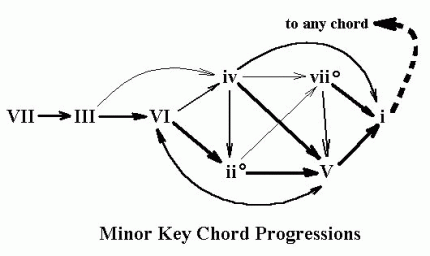
Many simple melodies alternate between I and V chords.
A huge number of songs use the I -> IV -> V -> I progression.
Pieces with more complex harmonies use chords farther to the left on the diagram and find the way back home along the pathways indicated.
The V -> I progression is very powerful and very satisfying to the listener. The dominant V chord introduces, enhances, and emphasizes the I which follows. Composers have concluded that the V -> I sequence is just too good a thing to be confined to the cadence at the end of the piece or major section thereof. They have found a way to use the same effect to lead into chords other than the I.
For a short time before it occurs, the composers switch to the key of the root of the chord to be emphasized and write the V7 -> I sequence in that key, then immediately return to the key of the piece after the emphasized chord is played. They have added a minor-seventh note to the V chord that identifies it to the ear as a dominant and not an ordinary diatonic triad. Since there is a temporary change of keys, the secondary dominant uses a chromatic note ... one not found on the diatonic scale in the key of the piece.
The Secondary Dominant is called a five of ... chord, e.g. five of five or five of two. This is written V7/V or V7/ii etc.
Still determined to get even more mileage out of the wonderful V7 -> I sequence, composers have strung several secondary dominants together. We can have sequences that look like: V7/ii -> V7/V -> V(7) -> I , one very often heard in popular music.
Note that every chord is the dominant five 7 of the chord that follows it.
If followed for 13 steps, the sequence leads back to the starting chord.
This is known as the Circle of Fifths.
In a real piece of music, one never finds a string of dominant sevenths more than 3 or 4 long.
For example, in the key of C, one often finds D7 ->
G7 ->
C, or A7 ->
D7 ->
G7 ->
C, and even rarely E7 ->
A7 ->
D7 ->
G7 ->
C.
The sequence I -> V7/IV -> IV is often heard. Here, the I7 chord is the same as the V7/IV and is formed by adding a minor seventh note to the I chord. In the key of C, this is C -> C7 -> F. The C7 (C E G Bb) is formed by simply adding the Bb note to the tonic C chord.
The above is intended to describe the chord structures and progressions most likely to be encountered by the beginning chromatic harmonica player. Those seeking information about tall chords (9th, 11th, 13th, etc.) or French, Italian and German augmented-six chords should look elsewhere.
The following diagram is authored by Steve Mugglin author of the Music Writers Website
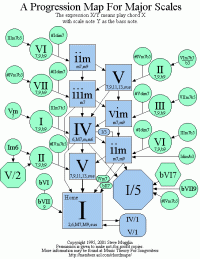
Steve Mugglin has kindly taken a lot of time to write his progression maps out in all twelve major keys and are very quick and easy to use. However THIS generic version of the same progression map requires little more thinking due to the generic notation used so that it can be applied to any key, meaning you only need to keep the one progression map with you at any time.
The roman numeral notation used is I, II, III, IV, V, VI & VII
which are the 1st, 2nd, 3rd, 4th, 5th, 6th & 7th chords respectively of any chosen key to be applied to the map.
Also by being in capital letters they indicate the chords are Major in nature (major 3rd from the root note).
e.g. If one were to apply the chord progression map to key of C Major, then I is the 1st chord starting with root note C, V is the 5th chord starting with the root note G.
When roman numerals are in lower case e.g. i, ii, iii, iv, v, vi & vii they remain 1st, 2nd, 3rd, etc chord of the chosen key, however the chords are minor in nature (minor 3rd from the root note).
e.g. if Key of C Major is used with this map then ii means the 2nd chord starting with the note D.
You treat the chart starting from any of the given coloured geometric shapes, think of them as pools of water that always flow down as if pools on a terraced hill, each pool is a chord in the progression
as you make your way finally down to the resolve... I.
As to how you choose to use this,
a small progression could be built for the chorus,
then another similar progression with a deviation could be done in a different key for the verses.
And yet another for a bridge.... but really the doors are open, its only limited by your imagination.
The map is a guideline, not a rulebook!
Thank you Steve Mugglin of the Music Writers Website
A fifth is the fifth note in a diatonic scale.
So for key of C major an ascending fifth is G.
The decending fifth is F.
To take this a step further, in key of G the ascending fifth is D,
if you continue to work out each ascending fifth for each resulting key in this way you eventually end up back at C.
This how the Circle of Fifths is worked out.
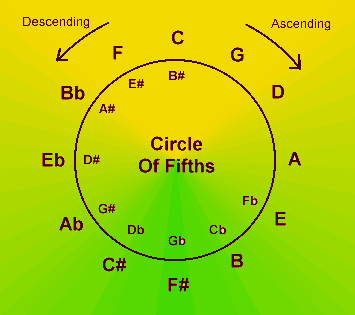
Working aroud the circle clockwise gives you ascending fifths. Going anticlockwise gives you descending fifths, also known as ascending fourths.
The Circle of Fifths is useful for:
Chromatic Harmonica is a popular choice of harp for Jazz. I HIGHLY recommend "Jazz Harp" by Richard Hunter which includes a lot of material on Jazz specifically for harmonica playing.
When approaching Jazz, understanding & using modes become very important. Instead of playing a given chord one can (within limits) play within a given key in the relavant mode relating to the chord being played.
The first thing to understand with why this makes sense can be drawn from everything else explained on this page and being very familar with your scales & basic music theory.
Consider the following:
When you have grasped the concept that Jazz substitutes mode keys for chords, the following chart becomes a useful starting point for chords & scales based on the Major scale.
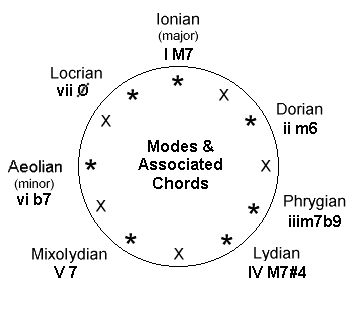
From the above chart combined with a chord progression you have the very basics for where to start when improvising in Jazz.
| II - V - I |
|---|
| ii - IV - V - I |
| iii - vi - ii - V |
| V of V V of V by transposing down a fifth (or up a fourth) with each change. |
These are only some of the progressions commonly found in Jazz music.
The relationship of the chords/modes is very dependant on which mode you start in.
Eg. For the II - V - I progression you may start in Myxolydian mode for the II chord,
this means the V chord is Ionian and the resolving I chord is Lydian mode.
A very common way of playing these changes is start in Dorian mode, followed by
Myxolydian resolving in Ionian mode.
By using the Circle of Modes, or the above mode/chord chart
you can assign chords to each mode starting with the chord & mode the progression begins
with, and therefore find out what mode you use for each chord of the progression.
Take care, if the modes are based on a different scale
(eg. the blues scale), then every mode's structure will be based on that scale.
This is just a glimpse of Jazz Theory!
There is a LOT more to Jazz than just scales, modes & progressions. Feel, timing, concepts, a developed sense of creativity & concept and familiarity are required. Please visit Music Theory III page in this site for further links on Jazz.
A brief explanation of the Blues Scale structure.
For the sake of completeness I've included this last section.
The blues scale is used in blues regularly.
Diatonic short harmonica players can use this scale by playing in second position or third position
using a number of bends to achieve the correct notes which in itself adds feeling & a more bluesy quality to the music.
It is derived from the pentatonic minor scale with an additional accidental.
Where (-) is a semitone, (--) is a wholetone. It can be mapped out thus:
Note the use of triple semitone gaps.
For example E Blues Scale:

Click on score to listen to the example.
Be aware that although this is the basic scale used, the rules here are made to be broken from time to time.
The basic Blues structure for the majority of 12 bar blues goes like this:
| I | I | I | I |
|---|---|---|---|
| IV | IV | I | I |
| V | IV | I | V |
For the chromatic instrument there are two approaches I can recommend.
When you are familiar with your chromatic harmonica, blues, the blues scales and blues licks & riffs: the other method is:
Blues Music Theory Tip: When improvising with the blues scale there
are a number of accidentals that fall between the blues scale that can be used
to harmonise with the tune. Blues is about disonance.
If you find the dominant 7th note for each bar you are playing in,
this gives an acceptable chromatic accidental that fits right in.
Eg. If you are playing in G blues, on the G chords (tonic or on the I bar)
you can play F as a "harmonising" blues note.
With C chords (4th or on the IV bar) its Bb and you'll find for the V bar,
with D chords the dominant 7th is C.
You can use this is by playing appegios (broken chords) for each bar,
playing the root or tonic note, the 3rd and the dominant 7th, and you can choose to leave
out the 5th or tonic.
If you wish to get fancy, after doing the appegio do a quick chromatic run
from the 3rd up to the 5th or vice versa, this works particularly well in Boogie Woogie blues.
Of course this is for early stages or when backing the soloist.
When soloing or as your musicality extends you'll find popular riffs,
you'll learn to play melodically over the changes,
and take musical ideas from the other soloists and learn to run with them.
I think playing blues with chromatic harmonica is a developing area. Brendan Power uses chromatic harmonicas for blues (and irish) as well as diatonic harmonicas. He uses half valved custom tuned chromatics to give a deeper range of note bends.
There are MANY websites on how to play blues, although not with the chromatic harmonica in mind.
For further information on playing blues visit:
The Diatonic Harmonica Reference
BluesHarp.Org
BluesTime.It
Harmonica Sessions
There are countless scales in the world of music. One source to finding any particular scale is Modes & Scales and Scaleopedia website. The beauty of the chromatic harmonica is they are all available to you!